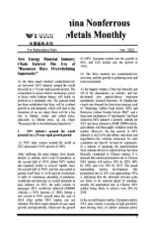Indonesia Tops the List of China’s Bauxite Import Sources
2011-08-15
The Industry Injury Investigation Bureau of the Ministry of Commerce has issued an early warning that China’s dependence on foreign bauxite is as high as 60%, of which bauxite from Indonesia accounts for more than 70% of the total import. Bauxite imported from Indonesia has, to a certain extent, dominated the development of China’s aluminum industry.The bauxite reserve is tremendous in the world while that remains on the brink of exhaustion in China. As China expands its production scale of bauxite, its import also rises continuously.
China imports bauxite primarily from Indonesia and Australia and imports a few from India.In 2010, China imported 22,927,000 tons of bauxite from Indonesia, accounting for 76.2%of its total import of bauxite; imported 6,587,000 tons of bauxite from Australia, accounting for 21.9% of its total import of bauxite; in addition, the proportion of China’s import of bauxite from India to its total import accounts for approximately 1.7%.According to an official of the Industry Injury Investigation Bureau of the Ministry of Commerce, in July 2011 alone, China’s import of bauxite from Indonesia in proportion to its overall import hit a new high of 84.19%.
China’s dependence on foreign bauxite has been rising and the number of sources restricted to a few countries.According to China’s customs statistics, in 2005 and 2006,the average price of bauxite that China imported from other countries stood at around USD 33/ton, while the price has risen to USD 45.2/ton during the first 7 months of 2011, and even hit USD 66/ton at its peak.
China’s limited capacity of supply and low grade of bauxite also drove costs up.
China is relatively deficient in bauxite resources, which is expected to be exhausted in 10 years on a static basis. Moreover, diasporic bauxite, which is hard to process and requires great energy consumption, accounts for more than 98% of the total reserves of the country.
On one hand, China is short of bauxite resources; On the other hand, its alumina production capacity has been growing.
During the first half of 2011, China has completed approximately 4,000,000 tons of alumina production capacity. As of the end of June 2011, China’s overall alumina production capacity has reached 45,320,000 tons, accounting for 85.4% and 41.3% of total production capacity of Asia and the world respectively.
An official of China Aluminum Association noted that China’s alumina production capacity tripled during the 11th Five-Year Plan period,most of which relied on red-clay bauxite from Indonesia.
“The risk of high concentration of material supply lies in that even a slight sign of uncertainty in the source country tends to stir the nerve of China’s aluminum market.” The above mentioned official of China Aluminum Asso ciation told the reporter, Indonesia’s economy grows fast and the awareness of utilizing and protecting its own resources has been improving, and there is often news about restrictions on export of main mineral resources.
At the beginning of 2011, Indonesian central government regained mineral resources examination & approval right from local governments at the county level, and the national government regulates and controls aluminum output and price in a centralized manner, which further increases the risk of fluctuation of China’s bauxite market.
Meanwhile, large-scale multi-national aluminum companies’ global monopolization of bauxite resources also increases risks of China’s aluminum industry.
The responsible person of CHINALCO overseas development department told the reporter that monopolization of multinational corporations poses a big threat to such countries relying greatly on import as China. Mining right and production capacity of some big countries with bauxite resources, such as Australia, have been controlled by global aluminum companies of the United States, which controls 25% of global production capacity and nearly 1/3 of global output of bauxite. In Jamaica and Brazil,more than 40% of bauxite resources are controlled by multinational companies.
In order to prevent the bauxite market from following in the footsteps of iron ore, Chinese enterprises are speeding up to prospect for bauxite abroad.
In August 2011, China Power Investment Corporation and Guinea inked a statement, according to which China will invest USD 6 billion to exploit bauxite and alumina in Boffa of Guinea.“It is an inspiration for Chinese enterprises to expand utilization of raw materials globally.”An insider of China Aluminum Association said so.China enterprises are also actively seeking other approaches to reduce risks of the industry, such as building bauxite and alumina resources reserve bases, purchasing and storing bauxite and alumina resources for long term use as well as actively developing domestic resources, so as to ensure sufficient supply of bauxite resources.
In the view of an official of the Overseas Development of CHINALCO, restrictions on blind expansion of alumina production capacity is another effective approach to control risks of China’s aluminum industry.
In the wake of the financial crisis, China’s alumina production capacity is plagued by low utilization, massive idle assets and serious waste of resources. Therefore, “under the condition of current demand for alumina at home and abroad, we shall postpone investment in expansion of alumina production capacity,eliminate obsolete production capacity, and make more investment in environmental protection equipments.” the responsible person said so.
杂志排行
China Nonferrous Metals Monthly的其它文章
- Xinjiang to Build Its Largest Copper Mine
- China’s Manufacture Industry Drives Copper Demand to Keep Steady Growth
- Gigantic Copper-Molybdenum Mining Project Contract Signed in Guangdong
- China’s Nonferrous Metals Industry Enjoys a Promising Prospect During the 12th Five-Year Plan Period
- Tongling: Copper Industry Giant Takes Shape
- Aluminum Price to Maintain Upward Trend Thanks to Acceleration of Low-income Housing Construction
